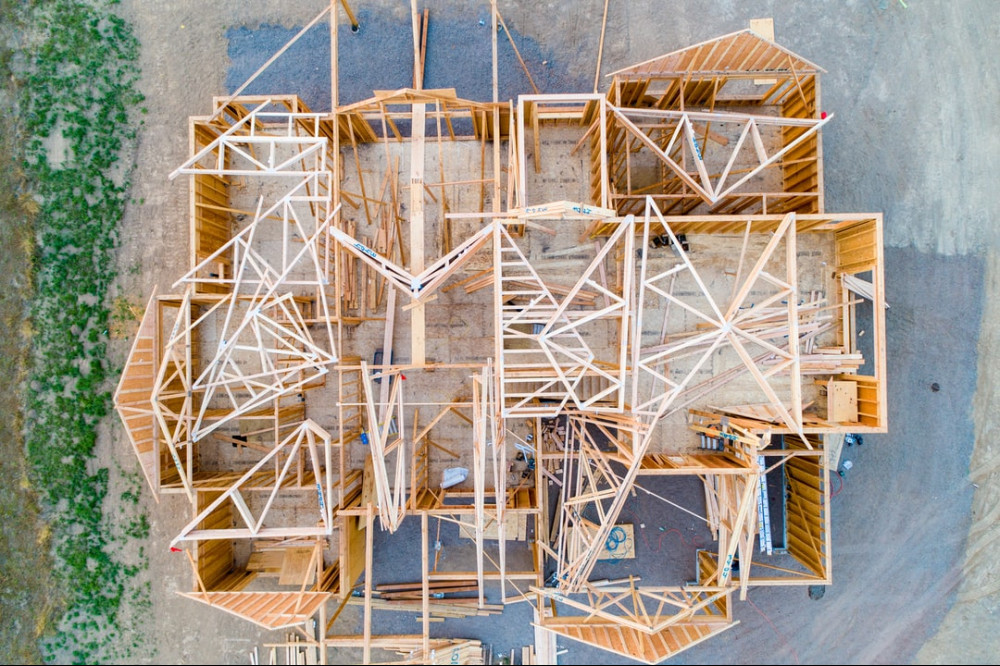If you want to build a shed or a cabin or maybe even a house, nowadays there is a ton of useful resources online to get you going. But if you are just starting out and don’t have a basic knowledge of house framing terminology, you are gonna have a hard time following along.
Although there is a great deal of high quality YouTube videos on the subject, I found that too often people making them just use the terms without explaining them. They kinda expect that you already know the basics and you will find yourself pausing and Googling terms more often than you expected. I sure know I did…
Therefore, I decided to try and put together a list of construction framing terms to make life easier for people who are just getting their feet wet with framing. If you think that I missed something or didn’t explain clear enough, make sure to let me know down in the comments.
Floor
Floor is the lowest part of your building. It rests on the foundation and provides the support for upper structure as well as a place for you to walk on.
We’ll start here because we are going to follow the order in which you would actually build your structure. It will also give you a sense of how the construction process actually goes.
Joist
Joists are the ribs of your floor so to say. They run parallel to the ground and support the subfloor that will be placed on top of them. They typically run across the width of the structure just like rafters do. Therefore, these two are usually parallel.
Rim joist / Header joist
These are the two joists that run perpendicular to all of the other joists and to which they are attached at each end. Usually they are positioned under the load bearing walls.
Subfloor
This is the layer that goes right on top of the floor joists. It is usually made out of OSB or plywood. As its name implies, it is under the actually floor that you would walk on.
Underlayment
Between a subfloor and the floor covering there is sometimes an extra layer called underlayment. It can be made out of various materials as it is used for various purposes. It can prove cushioning, insulation, vapor barrier, sound absorption, depending on your needs.
Floor covering
The top most floor layer and the one that you are actually walking on. There is a variety of options like boards, ceramic tiles, vinyl and many more. It all depends on your needs and the actual usage of the structure you are building
Walls

Continuing in the order you would build things, we come to the walls. There is a bit more to cover here, but don’t worry, it’s not rocket science.
Walls that provide support for upper levels (in multistory buildings) and roofs are called load-bearing walls.
Plate
Plates are horizontal members of the wall and are most commonly made of 2x4s. There are two types of them, bottom plate and top plate. The top plate is usually doubled so you have two top plates, one on top of the other. This doubling provides for extra strength, especially for load-bearing walls, but also has another purpose.
Typically, gable end wall’s upper top plate is cut 3 1/2 inches (width of a 2×4) longer on each side and the upper top plate on longer wall is cut 3 1/2 inches shorter on each side. This way top plates interlock and provide additional strength to the walls.
Stud
While plates are horizontal members, studs are the vertical ones. They are located between the bottom and top plates and connected to them. Together they make the structure of the wall and are also usually made with 2x4s. When it comes to the studs that surround a window or a door opening, the each have their name.
King stud
These are the outermost studs in an opening and they span the entire height of the wall.
Jack stud / trimmer stud
These studs are connected to the king studs on each side and are cut so that their height matches the top of the opening. Their role is to support the header which is placed above the opening.
Cripple stud
These are the shortest studs. They are located under the sill (bottom cripples) and above the header in cases where header doesn’t touch the top plate.
Sill
Bottom plate’s younger sibling, sills are short plates that make the bottom of the opening if it’s higher than floor level. Windows would have a sill, doors do not.
Header
Header is the bridge that spans over the width of the opening and sits upon jack studs. They are usually made with two 2x6s oriented sideways with a 1/2 inch plywood sandwiched in between them. This is done so that in total they match the 3 1/2 width of 2x material. There are other ways to make a header, including the insulated headers.
Please keep in mind that headers are necessary on load-bearing walls to give them the strength they need. On non-load-bearing walls they are not necessary and a simple plate can be used.
Blocking
Also known as nogging, these are the horizontal pieces of lumber that are placed between two studs and connected to them. They can be used for various reasons like giving additional strength to the studs, especially if the studs are longer.
One of the other uses would be to give you the ability to attach something to the walls in places where there are no studs. Blocking may provide support for kitchen cabinets, appliances, handrails or pretty much anything else.
Ladder blocking
This is a type of blocking that is most commonly used to provide a surface to nail interior walls to. As it is obvious from the name itself, pieces of 2x material are added horizontally between to studs with even spacing between them resembling a ladder.
It also provides a stop for drywall or other panels you would attach on interior walls.
Roof

We’ve finally arrived at the roof, the final piece of framing a house. There are many different kinds of roofs, like a gable roof, gambrel roof, lean-to roof, etc. As these are not all constructed in the same way, some of their components will vary. Here I’ll explain some of the main terms that cover almost all of the common constructions.
Rafter
Rafters are the ribs of the roof, just like joists are to the floor and studs to the walls. They span from the top wall plate to the ridge of the roof. The part of the rafters that goes past the wall plate makes the eaves.
Depending on the type of the roof, there can be different types of rafters. On a gable roof, all rafters will be the same. However, on more complex roofs you might need a variation of rafters like:
- Common rafters
- Hip rafters
- Valley rafters
- Hip jack rafters
Rafters are most commonly made from 2x material. Depending on the type of the structure, size of the roof and the load it must bear, rafters can be made from 2x4s to 2×12.
Batten
Battens are the smaller pieces of lumber that are placed perpendicularly on top of the rafters. Their main purpose is to provide a place for roof covering such as tiles or shingles to be attached to. They are not always present on roofs and sometimes material such as plywood or OSB can be placed over the rafters.
Roof joist
Roof joists are pretty similar to floor joists. They run horizontally from one load-bearing wall the opposing one, parallel to the rafters. They can provide additional support to the roof, make the core of the ceiling or the attic floor.
Ridge
The ridge is the highest point of the roof. On a simple gable roof it would be the horizontal line where two sides of the roof meet.
Ridge board
This is a board that runs along the ridge of the roof. In some types of roofs, rafters will run from the wall plate on one site to the ridge board on the other side. However, there are roofs where ridge board is not used and opposing rafters are attached to one another and usually reinforced with a piece of OSB board on each side to provide additional strength.
Bargeboard
This is a board that makes the face of the roof. It is very similar to rafters, usually is the same size and orientation, but protrudes from the roof on gable side. It conceals any otherwise visible horizontal members of the roof and gives it a clean look.
Fascia
The fascia board runs along the lower edge of the roof. In a way it serves a similar function as the bargeboard and I’ve seen some people call bargeboards fascia. However, not only do fascia boards cover the exposed lumber and provide a clean look, they also serve a couple of other functions. They can support the lowest end of tiles and also be the support for attaching gutters.
Fascia is attached to the bottom ends of rafters.
Soffit
These are the neighbors of fascia boards. They are oriented at a 90 degrees angle in relation to the fascia and go under the rafters all the way to the wall. As such, they cover the exposed rafters from underneath. This is a common place for ventilation openings that help prevent condensation in the roof and the damage it can produce.
Eaves
Eaves are parts of the roof which extend beyond the walls. Not all roofs have eaves but most do. They help drive water further away from the walls
Flashing
Roof flashing is thin metal material that is used around chimneys, windows, vents or other openings in the roof or in places where two slopes of the roof meet. They help make such places watertight .
Covering
Roof covering is the topmost layer of the roof, and the one that is actually visible once the roof is finished. There is a lot of options but some of the most common are:
- Roofing tiles
- Asphalt shingles
- Metal roofing
- Wooden shingles
- Wooden shakes
Gable
Gable is the triangular upper part of the wall that is located between two slopes of the roof. It gives name to some other terms like gable roof or gable end.
Pitch
Roof pitch is the steepness of the roof and is usually defined in one of two ways. In US, it is usually defined in ratio from 1/12 to 12/12. This defines how many inches the roof rises per 12 inches of depth.
The other common way to define pitch is in degrees of angle.
| Pitch | Degrees |
|---|---|
| 1/12 | 4.5 |
| 2/12 | 9.5 |
| 3/12 | 14 |
| 4/12 | 18.5 |
| 5/12 | 22.5 |
| 6/12 | 26.5 |
| 7/12 | 30.5 |
| 8/12 | 33.75 |
| 9/12 | 37 |
| 10/12 | 40 |
| 11/12 | 42.5 |
| 12/12 | 45 |
Final thoughts
We finally went through all of the basic terminology, from the floor to the roof. These are just some of the terms used in house framing because if I were to include each and every term, this article would turn into a book. However, they should be enough to get you going and clear out the initial confusion.
I hope this short list helps you get started in house framing. If you have any questions or suggestions, please let me know in the comments below the article.

